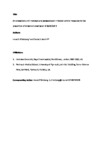An anaesthetic and intensive care perspective on infection control measures for the prevention of airborne transmission of SARS-CoV-2
| dc.contributor.author | O'Mahony, HR | |
| dc.contributor.author | Martin, Daniel | |
| dc.date.accessioned | 2020-12-18T13:17:26Z | |
| dc.date.available | 2020-12-18T13:17:26Z | |
| dc.date.issued | 2020-09-18 | |
| dc.identifier.issn | 1750-8460 | |
| dc.identifier.issn | 1759-7390 | |
| dc.identifier.uri | http://hdl.handle.net/10026.1/16760 | |
| dc.description | No embargo required. | |
| dc.description.abstract |
<jats:p> Guidance regarding appropriate use of personal protective equipment in hospitals is in constant flux as research into SARS-COV-2 transmission continues to develop our understanding of the virus. The risk associated with procedures classed as ‘aerosol generating’ is under constant debate. Current guidance is largely based on pragmatic and cautious logic, as there is little scientific evidence of aerosolization and transmission of respiratory viruses associated with procedures. The physical properties of aerosol particles which may contain viable virus have implications for the safe use of personal protective equipment and infection control protocols. As elective work in the NHS is reinstated, it is important that the implications of the possibility of airborne transmission of the virus in hospitals are more widely understood. This will facilitate appropriate use of personal protective equipment and help direct further research into the true risks of aerosolization during these procedures to allow safe streamlining of services for staff and patients. </jats:p> | |
| dc.format.extent | 1-9 | |
| dc.format.medium | Print-Electronic | |
| dc.language | en | |
| dc.language.iso | en | |
| dc.publisher | Mark Allen Group | |
| dc.subject | Aerosol | |
| dc.subject | Aerosol-generating procedures | |
| dc.subject | COVID-19 | |
| dc.subject | Personal protective equipment | |
| dc.subject | SARS-CoV-2 | |
| dc.title | An anaesthetic and intensive care perspective on infection control measures for the prevention of airborne transmission of SARS-CoV-2 | |
| dc.type | journal-article | |
| dc.type | Journal Article | |
| plymouth.author-url | https://www.webofscience.com/api/gateway?GWVersion=2&SrcApp=PARTNER_APP&SrcAuth=LinksAMR&KeyUT=WOS:000576671400022&DestLinkType=FullRecord&DestApp=ALL_WOS&UsrCustomerID=11bb513d99f797142bcfeffcc58ea008 | |
| plymouth.issue | 9 | |
| plymouth.volume | 81 | |
| plymouth.publication-status | Published | |
| plymouth.journal | British Journal of Hospital Medicine | |
| dc.identifier.doi | 10.12968/hmed.2020.0538 | |
| plymouth.organisational-group | /Plymouth | |
| plymouth.organisational-group | /Plymouth/Faculty of Health | |
| plymouth.organisational-group | /Plymouth/Faculty of Health/Peninsula Medical School | |
| plymouth.organisational-group | /Plymouth/REF 2021 Researchers by UoA | |
| plymouth.organisational-group | /Plymouth/REF 2021 Researchers by UoA/UoA01 Clinical Medicine | |
| plymouth.organisational-group | /Plymouth/Users by role | |
| plymouth.organisational-group | /Plymouth/Users by role/Academics | |
| dc.publisher.place | England | |
| dcterms.dateAccepted | 2020-09-09 | |
| dc.rights.embargodate | 2020-12-22 | |
| dc.identifier.eissn | 1759-7390 | |
| dc.rights.embargoperiod | Not known | |
| rioxxterms.versionofrecord | 10.12968/hmed.2020.0538 | |
| rioxxterms.licenseref.uri | http://www.rioxx.net/licenses/all-rights-reserved | |
| rioxxterms.licenseref.startdate | 2020-09-18 | |
| rioxxterms.type | Journal Article/Review |


